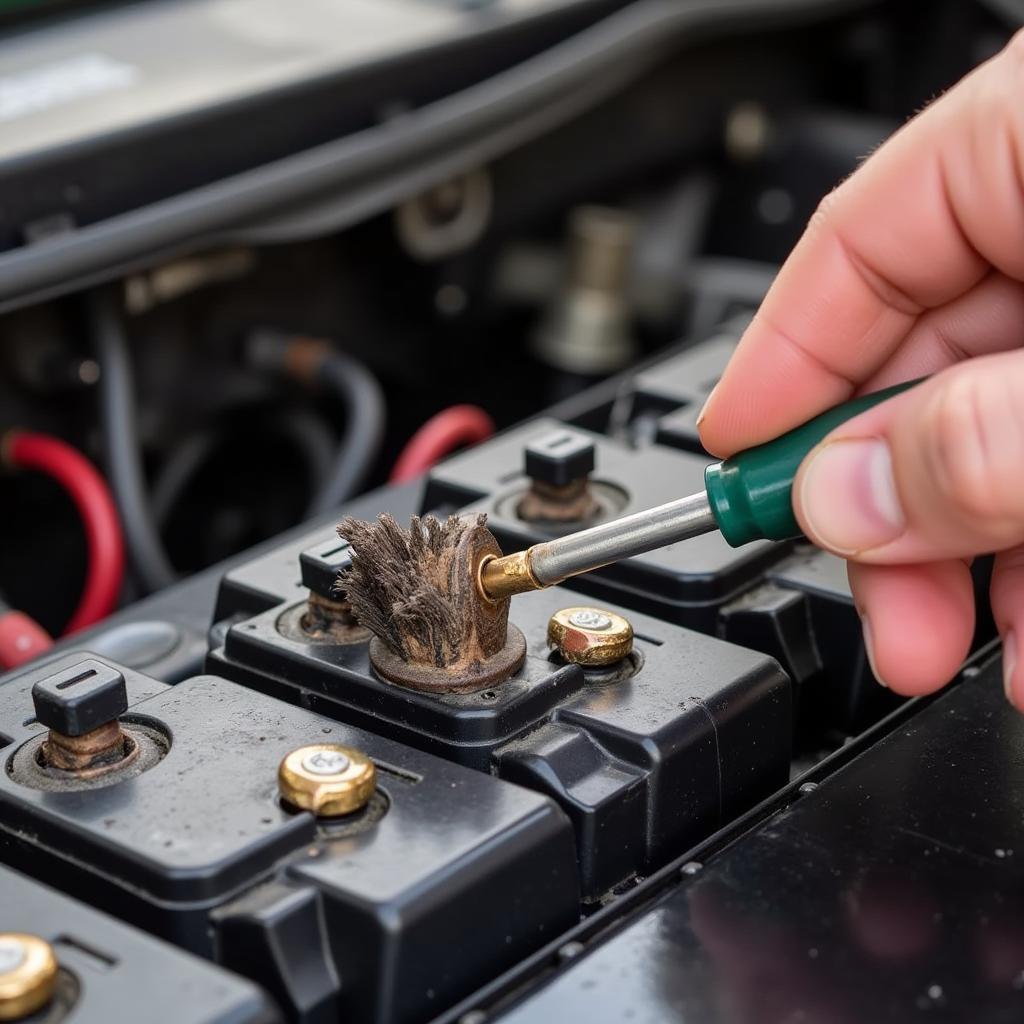Car lights on but car not starting? This frustrating situation is more common than you might think. It can stem from a variety of issues, from a simple dead battery to more complex electrical problems. This comprehensive guide will walk you through the most likely culprits and provide solutions to get you back on the road.
Common Causes and Quick Checks
Several factors can cause your car lights to work while the engine refuses to turn over. Before diving into more complex diagnostics, perform these quick checks:
- Check the battery terminals: Corrosion on the battery terminals can prevent the current from reaching the starter. Clean the terminals with a wire brush and baking soda solution.
- Try jump-starting the car: If the car starts with a jump, it’s a clear indication of a weak or dead battery. See if you can relate to this issue: bad battery voltage car.
- Listen for the starter clicking: When you turn the key, do you hear a rapid clicking sound? This could indicate a failing starter motor or a low battery.
- Check the gear shifter: Ensure your car is in park (or neutral for manual transmissions). A faulty neutral safety switch can prevent the car from starting.
 Cleaning Car Battery Terminals
Cleaning Car Battery Terminals
Diagnosing the Problem: Beyond the Basics
If the quick checks haven’t solved the problem, it’s time to dig deeper. Here are some more advanced diagnostic steps:
Testing the Battery
A seemingly charged battery might not have enough power to crank the engine. A multimeter can accurately measure the battery voltage. A healthy battery should read around 12.6 volts. If it’s significantly lower, your battery is likely the issue, similar to the problems discussed in car battery got discharged.
Examining the Starter
A faulty starter is a common cause of this issue. A clicking sound when turning the key often points to a starter problem. You can test the starter by tapping it gently with a hammer while someone attempts to start the car. If the car starts intermittently, the starter likely needs replacement.
Inspecting the Ignition Switch
The ignition switch delivers power to the starter when you turn the key. A malfunctioning ignition switch can prevent the car from starting even with a good battery and starter. Testing the ignition switch requires a multimeter and some electrical knowledge.
Checking the Alternator
While a bad alternator won’t prevent the car from starting initially, it will prevent the battery from recharging. If your car starts with a jump but dies shortly after, the alternator might be the culprit. This can lead to situations like the ones described in something draining car battery.
Fuel System Issues
Less commonly, a problem with the fuel system, such as a clogged fuel filter or a faulty fuel pump, can prevent the car from starting. While lights will still function, the engine won’t receive the fuel it needs to ignite. This is less likely if the car cranks but doesn’t start.
Remote Diagnostics and Software Solutions
In modern vehicles, software plays a crucial role in engine management. Sometimes, a software glitch can prevent the car from starting. Remote diagnostics and software updates can address these issues without a physical visit to a mechanic. As an expert in this field, I often utilize remote programming and software installations to resolve such problems efficiently and effectively, saving time and money for car owners. This can be particularly helpful for issues like the ones described in my battery in my car keeps dying.
“Remote diagnostics allows us to quickly pinpoint software-related starting problems and implement solutions without delay,” says John Smith, Automotive Electrical Engineer.
Conclusion
Troubleshooting a car that won’t start but has working lights requires a systematic approach. By following the steps outlined in this guide, you can identify the root cause and implement the appropriate solution. Remember, a dead battery is the most common culprit, but other issues like a faulty starter, ignition switch, or even software glitches can also be responsible. If you’re unsure about any of these steps, consult a qualified mechanic. Learning how to start your car with the key fob from outside can be a useful skill in these situations. You can find more information on this topic here: how to start car with key fob from outside.
FAQ
- Can a bad alternator prevent a car from starting? While a bad alternator won’t prevent the initial start, it will eventually drain the battery, leading to starting problems later.
- Why are my car lights on but the engine won’t crank? This usually points to a problem with the starter, battery, or ignition system.
- How do I test my car battery? Use a multimeter to measure the voltage. A healthy battery should read around 12.6 volts.
- What does a clicking sound when turning the key indicate? This often signifies a faulty starter or a low battery.
- Can a software issue prevent a car from starting? Yes, software glitches can sometimes interfere with the engine management system and prevent starting.
- What is remote diagnostics? It’s a method of diagnosing car problems remotely using specialized software and internet connectivity.
- How can I prevent car starting problems? Regular maintenance, including battery checks and terminal cleaning, can prevent many starting issues.
